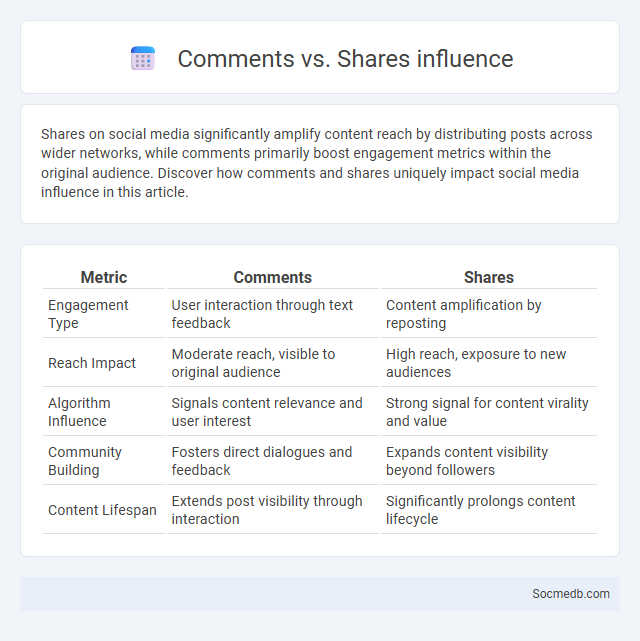
Photo illustration: Comments vs Shares influence
Shares on social media significantly amplify content reach by distributing posts across wider networks, while comments primarily boost engagement metrics within the original audience. Discover how comments and shares uniquely impact social media influence in this article.
Table of Comparison
| Metric | Comments | Shares |
|---|---|---|
| Engagement Type | User interaction through text feedback | Content amplification by reposting |
| Reach Impact | Moderate reach, visible to original audience | High reach, exposure to new audiences |
| Algorithm Influence | Signals content relevance and user interest | Strong signal for content virality and value |
| Community Building | Fosters direct dialogues and feedback | Expands content visibility beyond followers |
| Content Lifespan | Extends post visibility through interaction | Significantly prolongs content lifecycle |
Understanding Comments and Shares: Key Engagement Metrics
Comments and shares are critical social media engagement metrics that reflect audience interaction and content reach. Comments indicate user interest and sentiment by providing direct feedback and fostering community discussions. Shares amplify content visibility by distributing posts to a broader network, driving organic growth and enhancing brand awareness.
How Social Algorithms Prioritize User Interactions
Social media algorithms prioritize user interactions by analyzing engagement metrics such as likes, comments, shares, and time spent on content to determine relevance and personalize feeds. Platforms like Facebook and Instagram use machine learning models to predict which posts will generate the most meaningful interactions, boosting visibility accordingly. This dynamic ensures that content fostering active engagement receives higher ranking, enhancing user retention and platform usage.
The Impact of Comments on Content Visibility
Comments play a crucial role in enhancing content visibility on social media platforms by signaling engagement to algorithms, which prioritize posts with higher interaction levels. Your active participation through thoughtful comments can increase the reach and discoverability of posts, fostering a vibrant community around your content. Higher comment counts often lead to improved ranking in feeds, driving organic growth and boosting overall social media presence.
Shares as Amplifiers: Extending Content Reach
Shares act as powerful amplifiers on social media, dramatically extending the reach of your content beyond your immediate followers. Each share introduces your posts to new audiences, increasing visibility and potential engagement exponentially. By encouraging shares, you leverage the network effect to maximize the impact and lifespan of your content across multiple platforms.
Algorithmic Weight: Comments vs Shares
Social media algorithms prioritize engagement types differently, often assigning more weight to shares than comments because shares indicate content valuable enough to be distributed to a broader audience. Your posts that receive higher shares tend to reach greater visibility across platforms like Facebook and Instagram, boosting organic reach significantly. Comments foster community interaction and signal interest but generally impact algorithmic ranking less than shares, making shares crucial for expanding your content's influence.
Engagement Quality: Conversational vs Distribution Signals
Engagement quality on social media is determined by the balance between conversational signals and distribution signals, where conversational engagement includes meaningful interactions like comments and shares that spark dialogue among users. Distribution signals reflect the breadth of content reach, such as impressions and shares, but may lack depth in user interaction. Prioritizing conversational engagement leads to higher content relevance and fosters stronger community connections, enhancing overall platform engagement.
Platform Differences: Facebook, Twitter, and Instagram Algorithms
Facebook's algorithm prioritizes content based on user engagement, relevance, and relationships, favoring posts from friends, family, and groups to enhance personal connections. Twitter employs a real-time feed driven by recency and user interactions, with an algorithm that highlights trending topics, tweets from followed accounts, and personalized recommendations. Instagram's algorithm focuses on interests, timeliness, and user interactions such as likes, comments, and shares, promoting visually appealing content and Stories to maximize user engagement and retention.
Case Studies: Viral Content and Interaction Types
Analyzing case studies of viral content reveals key interaction types such as likes, shares, comments, and user-generated content that drive exponential reach on platforms like Instagram, TikTok, and Twitter. Successful campaigns often leverage emotional resonance and timely relevance, prompting extensive audience engagement and network amplification. Metrics from cases like the ALS Ice Bucket Challenge demonstrate how shareability and social proof catalyze massive participation and brand visibility.
Optimizing Content for Comments or Shares
To maximize engagement on social media, focus on creating content that encourages your audience to comment or share by asking open-ended questions and sparking meaningful conversations. Use compelling visuals and emotionally resonant stories to increase the likelihood that Your followers will interact and spread your message organically. Analyzing which posts receive the most engagement can help refine your strategy for future content optimization.
Future Trends in Algorithmic Ranking and Social Engagement
Future trends in algorithmic ranking emphasize increased personalization through AI-driven content curation, enhancing user engagement by analyzing behavioral data in real-time. Social engagement metrics will integrate sentiment analysis and video interaction rates, improving content visibility for creators and brands. Advances in neural networks will lead to more transparent algorithms, fostering trust while optimizing user experience across platforms like Instagram, TikTok, and YouTube.
 socmedb.com
socmedb.com